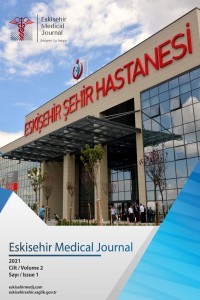Koroner no-reflow fenomeninde kontrast ilişkili akut böbrek hasarını öngördüren faktörler
Koroner arter hastalığı, kontrast ilişkili, no-reflow fenomeni, akut böbrek hasarı
Predictive Factors of Contrast-induced Acute Kidney Injury in the Setting of Coronary No-reflow Phenomenon
___
- 1. Chawla, R., Turlington, J., Arora, P., & Jovin, I. S. Race and contrast-induced nephropathy in patients undergoing coronary angiography and cardiac catheterization. International journal of cardiology, 2017;230,610-613.
- 2. L. Bergamaschi, S. Avondo, S. Buratti, et al. No-reflow after primary percutaneous coronary interventions in STEMI is an independent predictor of contrast induced acute kidney injury, European Heart Journal, Volume 38, Issue suppl_1, August 2017, ehx502.P1393, https://doi.org/10.1093/eurheartj/ehx502.P1393.
- 3. Yuan, Y., Qiu, H., Hu, X. Y., et al. Relationship between high level of estimated glomerular filtration rate and contrast-induced acute kidney injury in patients who underwent an emergency percutaneous coronary intervention. Chinese medical journal, 2018;131:17,2041.
- 4. Van der Molen, A. J., Reimer, P., Dekkers, I. A., et al Post-contrast acute kidney injury–part 1: definition, clinical features, incidence, role of contrast medium and risk factors. European radiology, 2018;28(7), 2845-2855.
- 5. Diab, O. A., Helmy, M., Gomaa, Y., & El-Shalakany, R. Efficacy and safety of coronary sinus aspiration during coronary angiography to attenuate the risk of contrast-induced acute kidney injury in predisposed patients. Circulation: Cardiovascular Interventions, 2017;10:1,e004348.
- 6. Yilmaz, M. B., & Yalta, K. Coronary flow slows as renal function worsens. Clinical Cardiology: An International Indexed and Peer‐Reviewed Journal for Advances in the Treatment of Cardiovascular Disease, 2009;32:5,278-282.
- 7. Chatterjee, S., Kundu, A., Mukherjee, D., et al. Risk of contrast‐induced acute kidney injury in ST‐elevation myocardial infarction patients undergoing multi‐vessel intervention‐meta‐analysis of randomized trials and risk prediction modeling study using observational data. Catheterization and Cardiovascular Interventions, 2017;90:2,205-212.
- 8. Boztosun, B., Gunes, Y., & Kirma, C. No-reflow'a guncel yaklasim/Current management of no-reflow. The Anatolian Journal of Cardiology (Anadolu Kardiyoloji Dergisi), 2006;6:3,255-261.
- 9. Celik, I. E., Kurtul, A., Duran, M., et al. Elevated serum fibrinogen levels and risk of contrast-induced acute kidney injury in patients undergoing a percutaneous coronary intervention for the treatment of acute coronary syndrome. Coronary artery disease, 2016;27:1,13-18.
- 10. ACT Investigators*. Acetylcysteine for prevention of renal outcomes in patients undergoing coronary and peripheral vascular angiography: main results from the randomized Acetylcysteine for Contrast-induced nephropathy Trial (ACT). Circulation, 2011;124:11,1250-1259.
- 11. Stefanos Gr. Foussas. Acute Coronary Syndromes and Renal Disease, Hellenic Journal of Cardiology, 2016;57:3,210-213.
- 12. Rear, R., Bell, R. M., & Hausenloy, D. J. Contrast-induced nephropathy following angiography and cardiac interventions. Heart, 2016;102:8,638-648.
- 13. Bitker, L., Sens, F., Payet, C., et al. Presence of kidney disease as an outcome predictor in patients with pulmonary arterial hypertension. American journal of nephrology, 2018;47:2,134-143.
- 14. Velibey, Y., Oz, A., Tanik, O., et al. Platelet-to-lymphocyte ratio predicts contrast-induced acute kidney injury in patients with ST-segment elevation myocardial infarction undergoing primary percutaneous coronary intervention. Angiology, 2017;68:5,419-427.
- 15. Li, Y., & Ren, K. The Mechanism of Contrast-Induced Acute Kidney Injury and Its Association with Diabetes Mellitus. Contrast media & molecular imaging, 2020.
- 16. Azzalini, L., Spagnoli, V., & Ly, H. Q. Contrast-induced nephropathy: from pathophysiology to preventive strategies. Canadian Journal of Cardiology, 2016;32:2,247-255.
- ISSN: 2718-0948
- Yayın Aralığı: Yılda 3 Sayı
- Başlangıç: 2020
- Yayıncı: Eskişehir Şehir Hastanesi
Diyabetik Ayak Ülseri ve Hemşirelik” Konulu Yayınların Bibliyometrik Analizi
Fadime KOYUNCU, Hatice AYHAN, Emine İYİGÜN
Koroner no-reflow fenomeninde kontrast ilişkili akut böbrek hasarını öngördüren faktörler
Gökay TAYLAN, Çağlar KAYA, İlhan KILIÇ, Cihan ÖZTÜRK, Kenan YALTA
Ayhan KÜP, Mehmet ÇELİK, Şeyhmus KÜLAHÇIOĞLU, Abdulkadi USLU, Mert EVLICE, Mehmet Muhsin TÜRKMEN, Ramazan KARGIN
Covid-19 Hastalarında D-dimer ve Eritrosit Dağılım Genişliği Arasındaki İlişkinin Klinik Önemi
İbrahim Alper YAVUZ, Onur GÖK, Utku GÜRHAN, Fuad ÖKEN
Çoklu Akciğer Metastazları İçin Stereotaktik Radyoterapi: Erken Klinik Sonuçlar
Is there a covid-19 transmission with percutaneous needle prick? A case report
Murat DUYAN, Serhat GÜNLÜ, Ali SARIDAŞ, Resmiye Nur OKUDAN
Berrin YALINBAŞ KAYA, Yonca YILMAZ ÜRÜN, İsmail YENİLMEZ, Yeliz MERT KANTAR, Ali TÜREYEN, Hatice HAMARAT, Zeynep IRMAK KAYA, Serdar EFE, Cansu DEMİRAL, Pamir ÇERÇİ, Muslih ÜRÜN
Neisseria animaloris'in neden olduğu bir pnömoni olgusu
Taylan ÖNDER, Sevil ALKAN, Çisil Şeyma ÖZEL, Safiye Bilge GÜÇLÜ KAYTA, Anıl AKÇA, Cihan YÜKSEL, Servan VURUCU
